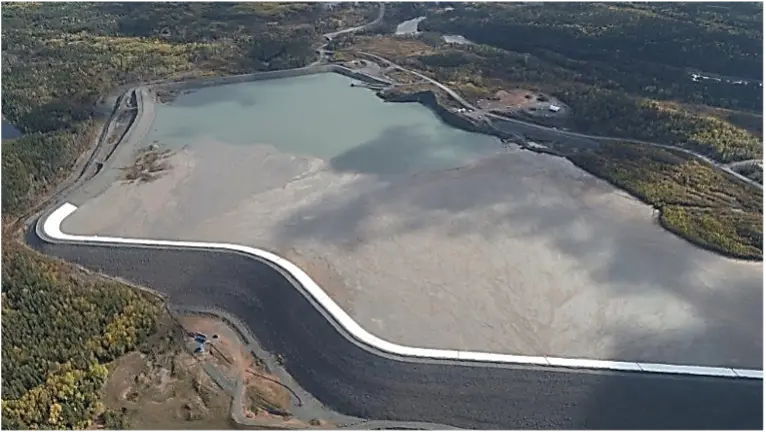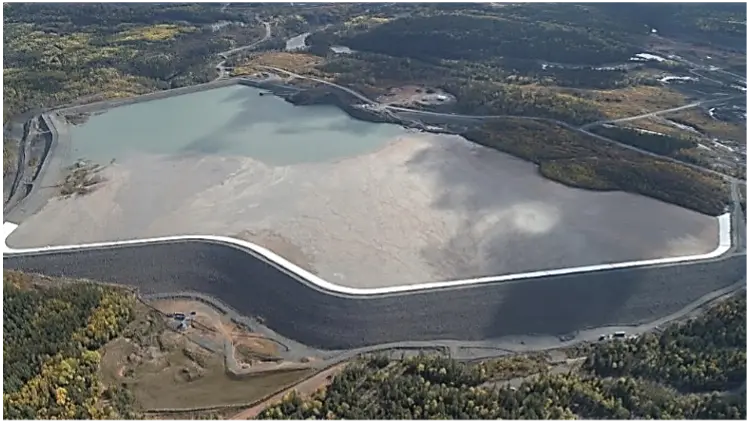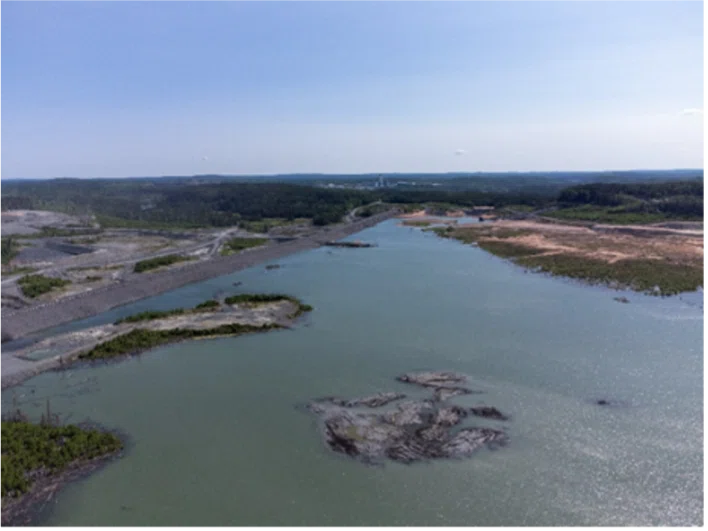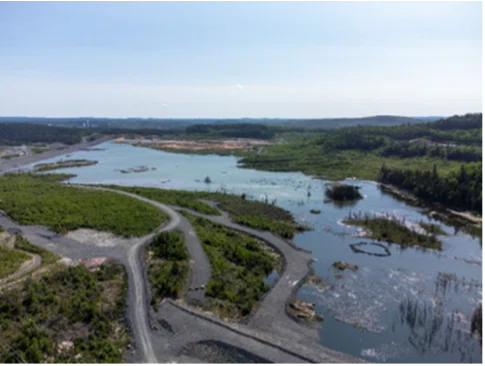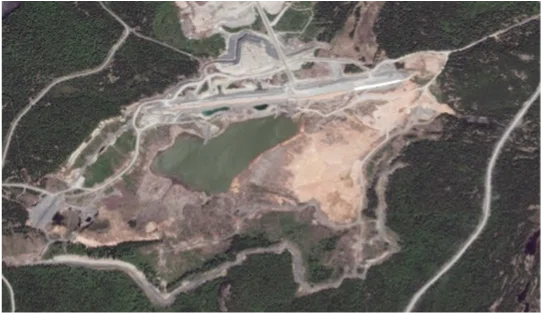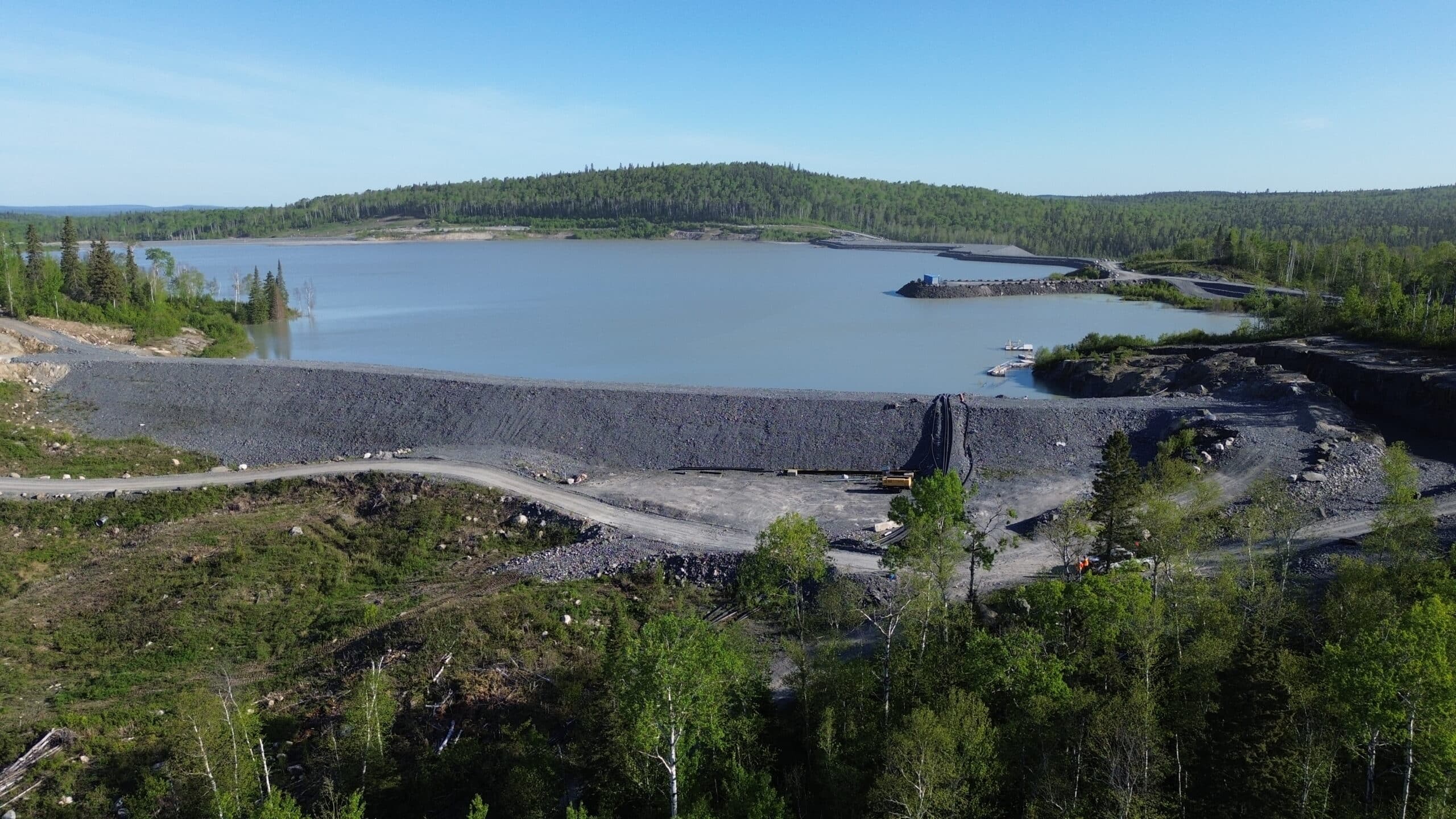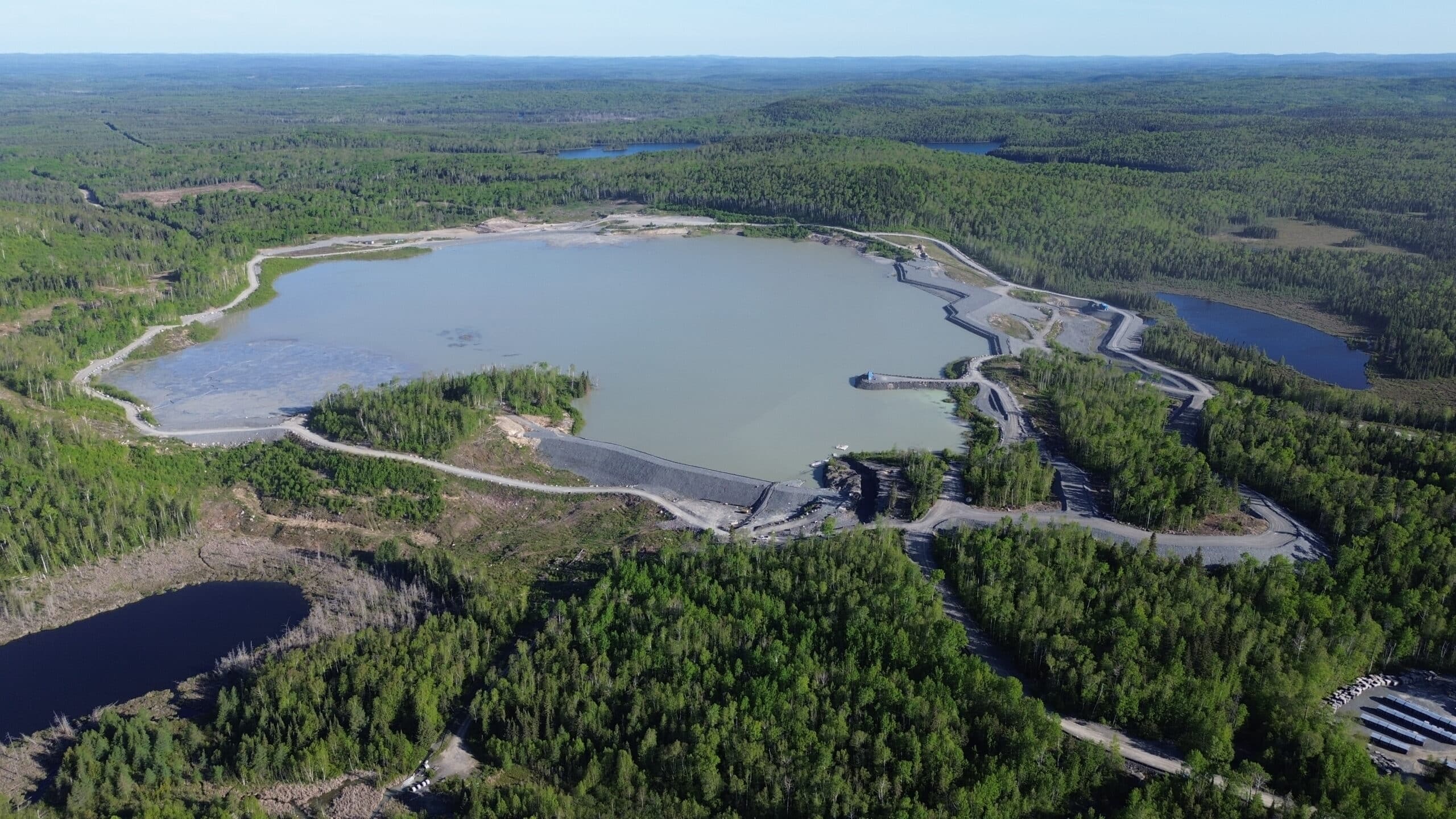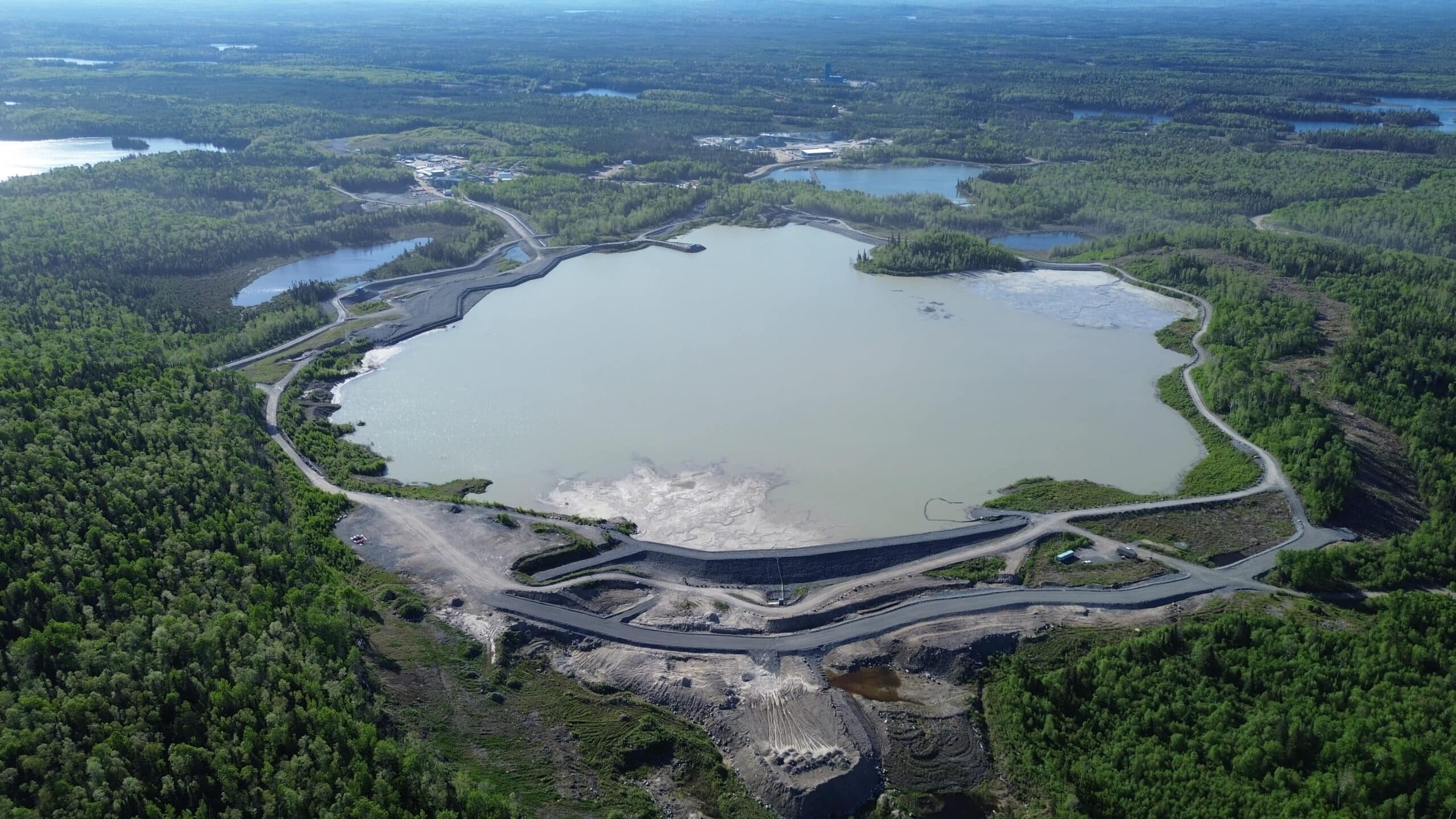
ESG Report 2023
Tailings
Background
Tailings are a common by-product of the mineral recovery process and often take the form of a liquid slurry consisting of finely crushed rock, water, and chemical additives used to facilitate mineral extraction. Following mineral processing, tailings are usually disposed within surface storage facilities (also known as tailings facilities or TFs). In some cases, tailings are used for underground backfill. The safe and responsible management of tailings is essential for protecting the natural environment, local communities, our operations, and workforce.
Tailings Disposal and Construction Methods
Some common methodologies for on-surface disposal of tailings include:
- impounding the liquid slurry behind dams
- storing dewatered tailings in a stack (also known as dry-stack tailings),
- co-disposal with waste rock, or
- in-pit storage utilizing existing mined-out pits.
The selection of the TF design depends on various parameters, including the geochemical composition of the tailings being stored, geotechnical/foundation considerations, precipitation, seismic activity, community preference, and environmental protection. The most common form of tailings storage across the mining industry is to construct a containment dam (or dams) in conjunction with natural topography to create a tailings facility.
There are several methods of constructing tailings dams. The method for each TF is chosen based on various factors as stated above, with the first priority being the safety and security of communities, employees, and the environment. Within these methods there are three (3) basic raise geometries defined by how the crest of the dam is increased in height relative to the original “starter dam” at the outset of the TF’s development: Upstream, Centerline, and Downstream.
Upstream
Upstream construction begins with a starter dam constructed at the ultimate toe of the facility. The tailings are then discharged into the facility where they form a tailings beach. Tailings will naturally segregate so that coarse material settles closest to the starter dam, while liquid and fine material settles farthest away. This tailings beach and the previous dam raise form the foundation for subsequent levels of the wall as the dam is raised. As such, the crest of the dam moves upstream with each raise.
Centerline
In the Centerline construction method, the dam is raised vertically on the centerline of the starter dam. The dam crest therefore remains fixed relative to upstream and downstream directions, as the dam is sequentially raised. Like the upstream method, the tailings are discharged on top of the dam to form a beach behind the dam wall. However, the dam wall only partially uses beached tailings for foundation support.
Downstream
Similar to the other construction methods, the Downstream design begins with a starter dam. Tailings are then discharged into the impoundment and as the embankment is raised, each new lift is constructed and supported on top of the downstream slope of the previous raise, so the dam crest moves downstream with each raise. Unlike the Upstream or Centerline construction methods, the dam wall does not rely upon beached tailings for the wall support.
Other Design Components
Beyond the three basic raise geometries outlined above, other impoundment types or components may be applied. Common to the mining industry are hybrid dams, water retaining dams, and landforms.
- Hybrid (or mixed) dams use a combination of the three raise techniques, often due to changes over the mine life (e.g., shortage of dam fill, building to higher design criteria).
- Water retaining dams are structures with specifically engineered features (e.g., low permeability liners or core zones) to safely manage stored water and seepage. These are suitable for storing water and tailings slurry in direct contact with the dam wall, and are generally constructed to full height at the beginning of the mine life.
- Landforms are typically legacy/closed TFs that are no longer impounding water. They may have undergone reclamation and rehabilitation (e.g., flattening and vegetating slopes) such that they no longer resemble their previous engineered state.
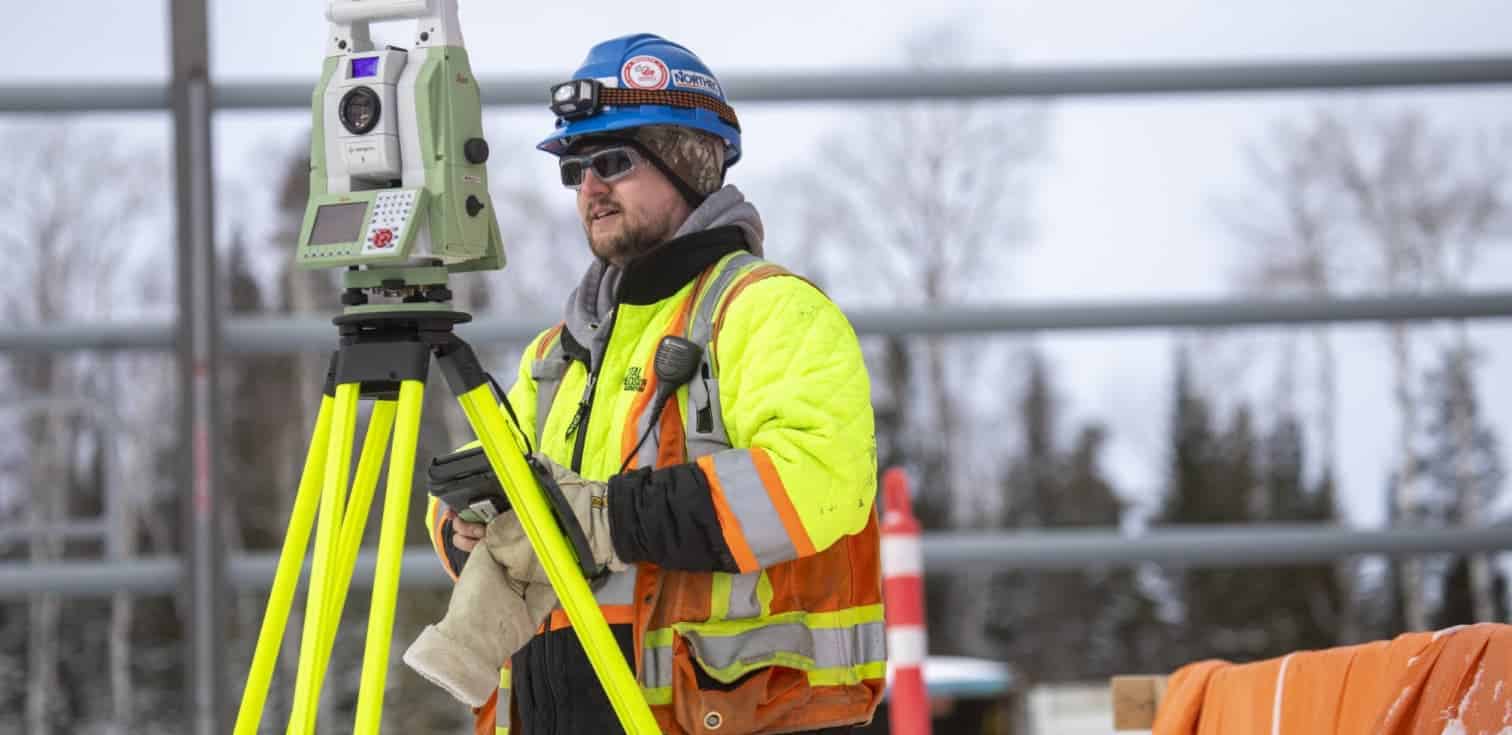
Tailings Governance
STRUCTURE
In 2023, Alamos formalized a new tailings governance structure. An Independent Tailings Review Board (ITRB), Tailings Management Working Group, and executive Tailings Management Steering Committee were established.
The ITRB, established in February 2023, is currently made up of 2 technical experts whose purpose is to provide an independent opinion on Alamos’ compliance or alignment with requirements described in the following:
- Alamos’ Tailings Management Standard (v1.1 – 2024)
- The Canadian Dam Association (CDA) Dam Safety Guidelines (2013)
- CDA Technical Bulletin: Application of Dam Safety Guidelines to Mining Dams (2019)
- The Mining Association of Canada’s (MAC) Guide to the Management of Tailings Facilities (2021)
- The Global Tailings Review’s Global Industry Standard on Tailings Management (2020)
Alamos’ Tailings Management Governance Charter outlines the purpose, composition, responsibilities and authority of the Tailings Management Working Group and the Tailings Management Steering Committee. The Working Group is comprised of the Director of Environmental Sustainability; the Engineer of Record; and each sites’ Responsible Tailings Person (typically General Manager or Mill Manager). The Group meets at least quarterly and is responsible for (1) directly supporting the ITRB, (2) the preparation of relevant reports, and (3) adherence to the Alamos Tailings Management Standard and each TF’s Operations, Maintenance & Surveillance Manual. The Steering Committee is made up of the Chief Operating Officer, the Senior Vice President (SVP) of Technical Services, the SVP of Projects, and the VP of Sustainability and External Affairs. The Committee also meets at least quarterly, and is tasked with responsibilities including but not limited to (1) reviewing the progress of the Working Group towards meeting company goals and initiatives, (2) reviewing the recommendations of and providing oversight to the ITRB, and (3) providing direction on evolving tailings management requirements, both internal and external.
While ultimate accountability for responsible tailings management remains at the most senior level of our business (with the Chief Operating Officer), the reporting structure begins at the site level. Site leadership works with Alamos’ ITRB, the Engineer of Record, and the Working Group, who then report to the Steering Committee. The Steering Committee reports to the Technical & Sustainability Committee of the Board.
Figure 6.4
Board of Directors
Technical & Sustainability Committee
Executive
Steering Committee
Corporate and Site Level
ITRB
Engineer of Record
Working Group
Island Gold
Young-Davidson
Mulatos
Lynn Lake
Corporate Sustainability
Internal Frameworks
The Alamos Sustainability Policy outlines our guidelines and commitment to exercise vigilance in all phases of the mining process. This includes the design, construction, operation and closure of TFs in a manner that protect life, health and the environment, and complies with applicable laws and international guidelines. The Policy commits the necessary human and financial resources to achieve this, including the provision of necessary training, equipment and systems to manage environmental and sustainability risks.
The Alamos Tailings Management Standard (v1.1 2024) defines the requirements for developing and implementing site-specific tailings management systems, and outlines the minimum expectations, practices and guidelines for the location, design, construction, operation, maintenance, surveillance, and closure requirements for our TFs. This Standard provides guidance to our operations in identifying, understanding, and managing TF-related risks. The Standard applies to all Company TFs that are planned, in construction, in operation, being closed and closed.

Tailings Management
OVERVIEW
Responsible tailings management is a core component of our operations and an important focus of Alamos. We are responsible for the treatment, storage, and management of tailings both during and after mining, and are subject to rigorous regulatory requirements that govern our efforts from design through to closure and reclamation. For our two tailings producing mines (Island Gold and Young-Davidson)1, Alamos constructs, maintains and manages each TF in close collaboration and consultation with government representatives, independent engineering firms, tailings experts and local stakeholders to mitigate risks. When designing our TFs, we work with independent experts to assess the local environment and potential risks of natural phenomena that can adversely affect the integrity of our facilities, including seismic events, flooding and operational constraints. We also consider the TF location relative to our operations, local communities and environmentally sensitive areas. These conditions are incorporated into our TF design and management practices. In addition, we follow recommendations from the Mining Association of Canada’s (MAC) Guide to the Management of Tailings Facilities and the Canadian Dam Association’s (CDA) Guidelines and Technical Bulletins for the design, construction, operation, closure and post-closure of TFs. TF closure and rehabilitation objectives are factored into decision making throughout the mine life cycle. Closure and rehabilitation plans are developed in accordance with applicable laws and international guidelines, and as such are periodically updated throughout the mine life and approved through the regulatory process.
We proactively engage with government, Indigenous communities, regulators, and communities of interest concerning our operations and TFs. Consultation includes the disclosure of potential risks, and information gained through this exercise is factored into decision making and the update of site environmental and sustainability plans.
2023 Tailings Produced (t)
Table 6.1
| Tailings Type | Young-Davidson | Island Gold | Mulatos |
|---|---|---|---|
| Surface Tailings | 1,215,097 | 439,008 | 0 |
| Sub-Surface Tailings | 1,662,950 | 0 | 0 |
| Total Tailings | 2,878,047 | 439,008 | 0 |
Alamos Tailings Facilities
Table 6.2
| Mine | Facility | Type | Raising Method | Status |
|---|---|---|---|---|
| Young-Davidson Mine | Tailings Impoundment Area -7 | Slurried tailings | Downstream and centerline | In operation |
| Young-Davidson Mine | Tailings Impoundment Area -1 | Slurried tailings | Centerline | In operation |
| Island Gold Mine | Primary Pond | Slurried tailings | Downstream | In operation |
Monitoring, Inspections and Audits
Each TF is supported by an Operations, Maintenance & Surveillance (OMS) Manual aligned to MAC’s OMS Guide. Three levels of governance and assurance are required and in place:
- Surveillance inspections and monitoring: Routine daily, monthly and quarterly inspections, instrumentation monitoring, and data analysis by qualified persons with sufficient training, experience and understanding of the TF.
- Dam Safety Inspections: Annual independent inspections undertaken by a qualified Professional Engineer, typically the Engineer of Record (EOR) assigned to the TF.
- Design and Construction Audits: Periodic independent reviews (Dam Safety Review and inspections by the Independent Tailings Review Board) of the design and construction of the TF to assess the integrity and safety of the TF.
TF monitoring, inspections and audits are undertaken in accordance with Canadian regulations and guidelines from the Canadian Dam Association. Any findings or non-conformances from independent inspections and audits are reported to mine management, Alamos’ Tailings Steering Committee and where warranted to the Technical & Sustainability Committee of the Board.
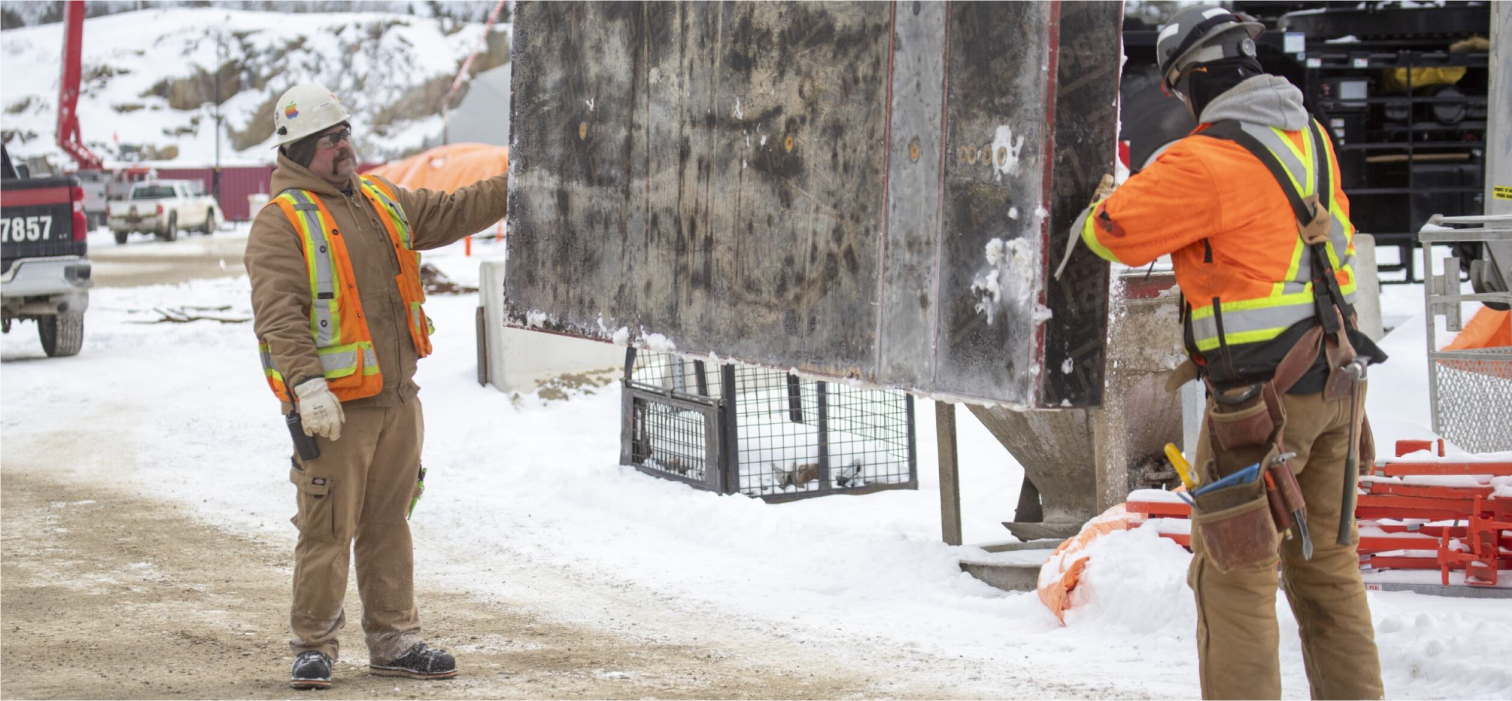
Continuous Improvement
As part of our overall sustainability performance initiatives, Alamos maintains programs to facilitate the continuous improvement of tailings management practices. This includes site-specific Emergency Preparedness and Response Plans (EPRP) and testing the EPRP protocols to identify issues, assess knowledge gaps and develop remediation plans.
In 2021 Alamos completed an internal assessment of its performance against the Global Industry Standard on Tailings Management (GISTM). The results of the assessment were used to identify opportunities for improvement, and to inform site plans to remediate higher-risk gaps. We continued to address these gaps through 2023. At the Young-Davidson Mine, we prepared a Climate Change model to review how future changes in temperatures, precipitation and evaporation may affect long-term design plans for the closure of our tailings facilities. At Island Gold, we improved environmental safeguards pertaining to cyanide offload and storage.
Following the 2022 construction of a second TF at the Young-Davison mine (TIA-1), updates to the OMS Manual and a new Dam Breach Analysis (DBA) are underway. A Dam Safety Review (DSR) was completed in 2023 to include both TIA-7 and TIA-1.
At the Island Gold Mine, a seismic hazard assessment was finalized in 2022 to improve our understanding of earthquakes and other vibrations that could potentially affect the TF, and we will incorporate this information into the design of future tailings lifts. An updated DBA and OMS Manual was completed in 2023 and a DSR will take place in 2024.
A part of Alamos’ Year 1 review with the ITRB, detailed site inspections were completed at each of our TFs. Relevant documents were also reviewed in detail, including documentation surrounding existing site conditions, various stages of tailings lift construction as-builts, previous Dam Safety Inspections, and Reviews. Current tailings and water management practices were also reviewed along with a look ahead to closure planning for each facility. Recommendations were provided for each facility which included completing a detailed risk assessment, ongoing seepage monitoring, planning for closure, and continued progress to meeting GISTM requirements. Another recommendation was to look at additional support for the ITRB beyond the existing technical review to start reviewing environmental, social, and regulatory items.
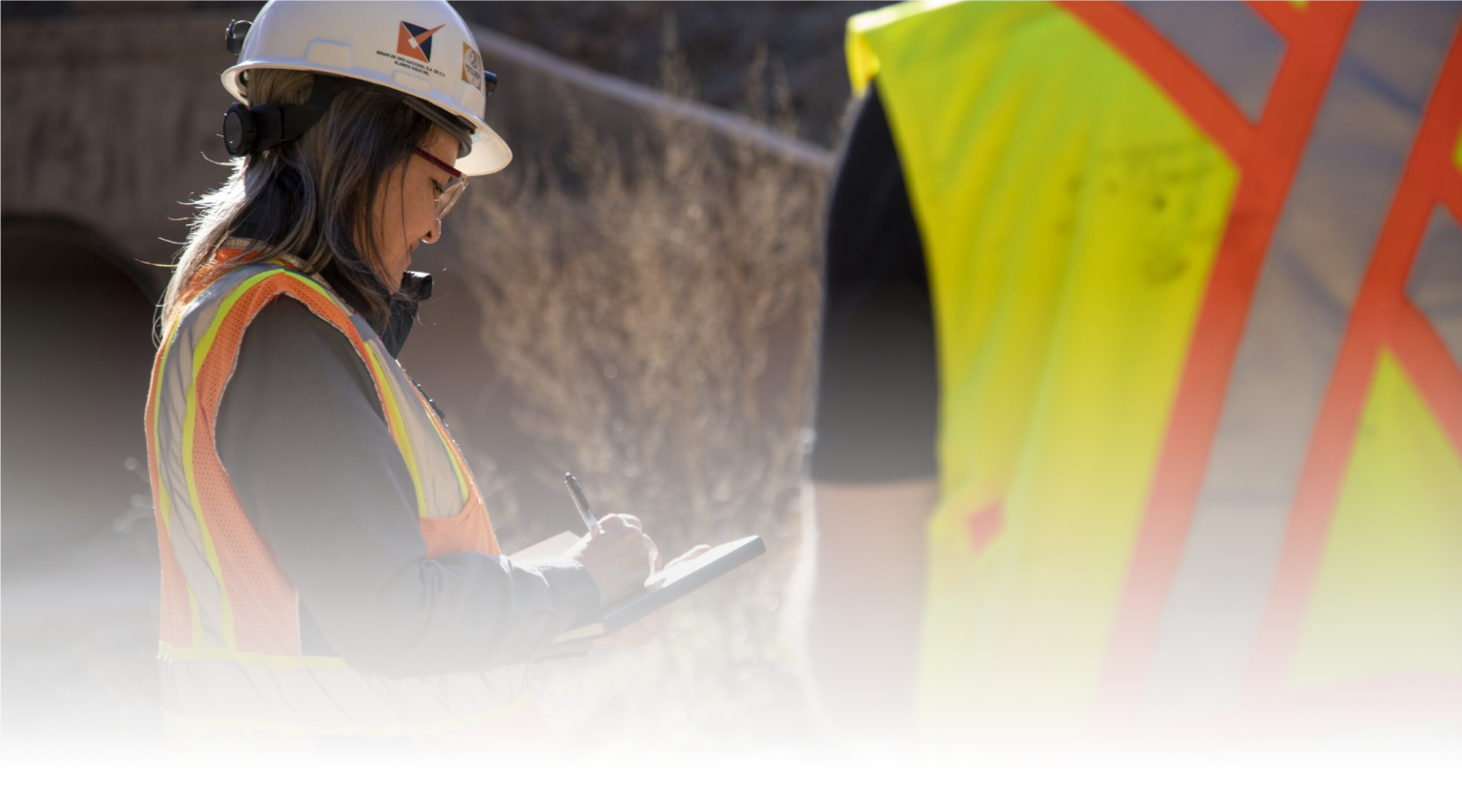
Facility Specifications
Facility Specifications
Young-Davidson Mine, Ontario Canada
Owner: Alamos Gold Inc.
Facility: Tailings Impoundment Area –7
Location: 47°56’56.4”N 80°42’50.4”W
| Facility Name | Status | Current TF Volume (million m3) | Planned TF Volume in 5 years (million m3) | Infrastructure Identifier | Date of Initial Operation | Dam currently operated or closed as per currently approved design | Raising Method | Current Maximum Dam/Dyke Height (metres) | Most recent independent expert review |
|---|---|---|---|---|---|---|---|---|---|
| Tailings Impoundment Area – 7 | In Operation | 14.9 | 15 | East Dam | 2012 | Yes | Downstream | 50 | 2023 (EXP) |
| West Dam | 2012 | Yes | Centerline (modified centerline on last lift) | 40 | |||||
| North Dam | 2014 | Yes | Centerline (modified centerline on last lift) | 12 | |||||
| South Saddle Dam | 2018 | Yes | N/A – Lined earthfill structure abutting upstream against an existing access road | 7 | |||||
| Full and complete relevant engineering records including design, construction, operation, maintenance and/or closure | Facility hazard categorization, based on the consequence of failure | Guidelines Used | Have notable stability concerns ever been identified throughout the facility life, as identified by an independent engineer? | Internal or External Engineering Oversight and Support | Formal Analysis of Downstream Impacts Completed | Closure plan and long-term monitoring in place | Impacts of long term climate change is being assessed | Other relevant information and/or supporting documentation | |
| Yes | High | Ontario Ministry of Natural Resources Classification and Inflow Design Criteria (2011) | No | Yes | Yes – In 2013 | Yes | Yes | N/A | |
| Yes | High | No | Yes | Yes – In 2013 | Yes | Yes | |||
| Yes | High | No | Yes | Yes – In 2013 | Yes | Yes | |||
| Yes | High | No | Yes | Yes – In 2013 | Yes | Yes |
Young-Davidson Mine, Ontario Canada
Owner: Alamos Gold Inc.
Facility: Tailings Impoundment Area –1
Location: 47°56’02.4”N 80°42’28.8”W
| Facility Name | Status | Current TF Volume (million m3) | Planned TF Volume in 5 years (million m3) | Infrastructure Identifier | Date of Initial Operation | Dam currently operated or closed as per currently approved design | Raising Method | Current Maximum Dam/Dyke Height (metres) | Most recent independent expert review |
|---|---|---|---|---|---|---|---|---|---|
| Tailings Impoundment Area -1 | In Operation | 3.15 | 18 | North Dam | 2023 | N/A | Centerline | 20 | 2023 (EXP) |
| West Dam | 2023 | N/A | Centerline | 9 | |||||
| East Saddle Dam | 2023 | N/A | Centerline | 11 | |||||
| Full and complete relevant engineering records including design, construction, operation, maintenance and/or closure | Facility hazard categorization, based on the consequence of failure | Guidelines Used | Have notable stability concerns ever been identified throughout the facility life, as identified by an independent engineer? | Internal or External Engineering Oversight and Support | Formal Analysis of Downstream Impacts Completed | Closure plan and long-term monitoring in place | Impacts of long term climate change is being assessed | Other relevant information and/or supporting documentation | |
| Yes | High | Ontario Ministry of Natural Resources Classification and Inflow Design Criteria (2011) | No | Yes | Yes – In 2015 | Yes | Yes | N/A | |
| Yes | High | No | Yes | Yes – In 2015 | Yes | Yes | |||
| Yes | High | No | Yes | Yes – In 2015 | Yes | Yes |
Island Gold Mine, Ontario Canada
Owner: Alamos Gold Inc.
Facility: Primary Pond
Location: 48°18’30.2”N 84°26’47.7”W
| Facility Name | Status | Current TF Volume (million m3) | Planned TF Volume in 5 years (million m3) | Infrastructure Identifier | Date of Initial Operation | Dam currently operated or closed as per currently approved design | Raising Method | Current Maximum Dam/Dyke Height (metres) | Most recent independent expert review |
|---|---|---|---|---|---|---|---|---|---|
| Primary Pond | In Operation | 2.5 |
4.2 (Crest Elevation of 430m) |
Dyke 1 | 1988 | Yes | Downstream | 17 |
2019 (Golder Associates)
Update planned 2024 |
| Dyke 2 | 2011 | Yes | Downstream | 9 | |||||
| Dyke 3 | 2011 | Yes | Downstream | 12 | |||||
| Dyke 4 | 2011 | Yes | Downstream | 15 | |||||
| Dyke 5 | 2015 | Yes | Downstream (planned) | 6 | |||||
| Full and complete relevant engineering records including design, construction, operation, maintenance and/or closure | Facility hazard categorization, based on the consequence of failure | Guidelines Used | Have notable stability concerns ever been identified throughout the facility life, as identified by an independent engineer? | Internal or External Engineering Oversight and Support | Formal Analysis of Downstream Impacts Completed | Closure plan and long-term monitoring in place | Impacts of long term climate change is being assessed | Other relevant information and/or supporting documentation | |
| Yes | High | Canadian Dam Association – Dam Safety Guidelines (2013) | No | Yes | Yes – In 2023 | Yes | Yes | N/A | |
| Yes | Significant | No | Yes | Yes – In 2023 | Yes | Yes | |||
| Yes | High | No | Yes | Yes – In 2023 | Yes | Yes | |||
| Yes | High | No | Yes | Yes – In 2023 | Yes | Yes | |||
| Yes | High | No | Yes | Yes – In 2023 | Yes | Yes |
References
Footnotes
- The Mulatos Mine does not produce tailings as it processes gold by heap leaching and carbon adsorption. ↩


